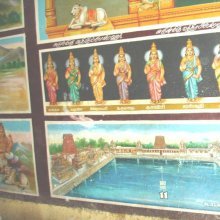Ganga-Yamuna: 2 definitions
Introduction:
Ganga-Yamuna means something in the history of ancient India. If you want to know the exact meaning, history, etymology or English translation of this term then check out the descriptions on this page. Add your comment or reference to a book if you want to contribute to this summary article.
Images (photo gallery)
India history and geography
Source: Knowledge Traditions & Practices of India: Other Technologies: A SurveyGanga-Yamuna region.—The first appearance of glass objects in India, according to current knowledge, is from the upper Ganga-Yamuna region and datable to the last centuries of the 2nd millennium BCE. At sites such as Bhagwanpura (Haryana), Kopia (U.P.), glass beads and bangles were found. In the following centuries, glass technology spread all over India.
Source: Cologne Digital Sanskrit Dictionaries: Indian Epigraphical GlossaryGaṅgā-yamunā.—(EI 24, 29), royal insignia probably con- sisting of the representation of the Gaṅgā and Yamunā on the flags or at the gate. Note: gaṅgā-yamunā is defined in the “Indian epigraphical glossary” as it can be found on ancient inscriptions commonly written in Sanskrit, Prakrit or Dravidian languages.

The history of India traces the identification of countries, villages, towns and other regions of India, as well as mythology, zoology, royal dynasties, rulers, tribes, local festivities and traditions and regional languages. Ancient India enjoyed religious freedom and encourages the path of Dharma, a concept common to Buddhism, Hinduism, and Jainism.
See also (Relevant definitions)
Partial matches: Yamuna, Ganga.
Full-text: Vijjha, Pacina Sutta, Pancanadi, Sarayu, Ummagga Ganga, Ramamantra, Pujavidhana, Shivapuja, Veni, Ahicchatra, Himava, Anotatta.
Relevant text
Search found 31 books and stories containing Ganga-Yamuna, Gaṅgā-yamunā; (plurals include: Yamunas, yamunās). You can also click to the full overview containing English textual excerpts. Below are direct links for the most relevant articles:
Settlement in Early Historic Ganga Plain (by Chirantani Das)
Part 3 - Hinterland and population of Rājagṛha < [Chapter II - Origin and Function of Rājagṛha as the seat of Monarchy]
Part 6 - Demography (middle and lower Ganga plain) < [Conclusion]
Part 1 - The Nodal Points and Early Human Activities < [Chapter I - The Case Study of Rājagṛha]
Garga Samhita (English) (by Danavir Goswami)
Verse 3.1.23 < [Chapter 1 - The Worship of Śrī Girirāja]
Golden Presentation < [January – March, 1978]
'The Triple Stream' < [July-August 1934]
Here is another Confluence < [January – March, 1978]
The Garuda Purana (by Manmatha Nath Dutt)
Chapter XXIII - Description of another form of Shiva worship < [Agastya Samhita]
Annadatri-carita (study) (by Sarannya V.)
3. The Voyage of Vancishvara depicted in Annadatri-carita < [Chapter 5 - Annadatri-carita—A Critical Study]
The Padma Purana (by N.A. Deshpande)
Chapter 22 - An Eulogy of Gaṅgā, Yamunā, Prayāga < [Section 6 - Uttara-Khaṇḍa (Concluding Section)]
Chapter 81 - The Importance of Gaṅgā < [Section 6 - Uttara-Khaṇḍa (Concluding Section)]
Chapter 136 - The Greatness of Nanditīrtha < [Section 6 - Uttara-Khaṇḍa (Concluding Section)]
Related products


